
The large white trumpet-shaped flowers of Easter lily, Lilium longiflorum, are a tradition at this time of year. These plants are forced to bloom at the appropriate time for the religious holiday, completely out of their normal flowering time. Native to the three small southern islands of Japan (Liu-chiu (Ryukyu) Islands), this species was distributed to other parts of the world a long time ago. It was being cultivated on the mainland of China and Japan when early Western explorers reached the area. In 1777 the famous plant explorer Carl Peter Thunberg discovered this lily and sent it to England in 1819. By the 1880’s bulbs were being grown commercially in Bermuda for shipment to the US, but by the turn of the century Japan dominated the US export market. When the supply of stock from Japan was cut off when World War II began with the bombing of Pearl Harbor, prices rose, making commercial cultivation of these bulbs economically feasible in the US. Today almost all of the potted plants grown as Easter lilies are produced by less than a dozen growers located in a narrow coastal region along the border of California and Oregon. Most of those are the cultivar ‘Nellie White’, a selection by grower James White named for his wife. Bulbs are grown for 3 or 4 years, replanted each year in the fields of this area with the perfect growing conditions, until they reach the right size and maturity. They are then shipped to commercial greenhouse growers throughout North America, where they are forced under controlled conditions to flower in time for Easter. Since Easter falls on a different day each year (the first Sunday following the first full moon of the vernal equinox, which may be anywhere between March 22 and April 25), careful scheduling is critical to ensure they are at the perfect stage during the approximately two week marketing window.
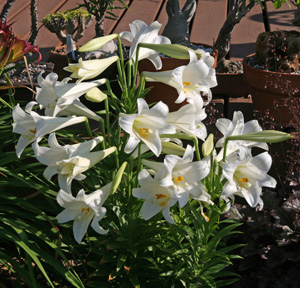
The average gardener isn’t going to go to these extremes to get their lilies to bloom out of season, but this species is a welcome addition to the summer garden when grown in-ground. They can be planted in masses to create a beautiful border or interspersed with other perennials in mixed borders. They are great additions to specialty gardens such as white gardens, cutting gardens or fragrant gardens. L. longiflorum is hardy in zones 5-11 (and into zone 4 with protection; a few cultivars are hardy only to zone 7).
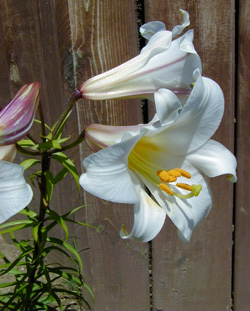
L. longiflorum is a stem rooting lily that grows up to 3 feet tall (forced plants are shorter because hormones are used to control their growth). Not all plants will grow to the maximum height, especially those in more northerly latitudes. The taller, more vigorous variety eximium, from the Ryukyu Islands, is cultivated as a cut flower. The single stem growing from the bulb is covered with narrow lanceolate leaves up to 6” long. More leaves are produced in cool conditions. The stems are quite sturdy and rarely require staking.
Two or more terminal flowers are held on strong stalks facing outward and perpendicular to the stem. Vigorous plants may have 12-15 flowers. The very fragrant flowers open in July in Wisconsin.
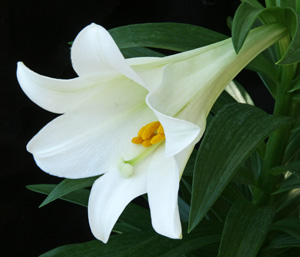
Each tubular flower is 3-7 inches long with the petals overlapped to create a trumpet shape. The ones sold as container plants around the Easter holiday season have white flowers but there is a range of flower color in this species, so other cultivars may come in shades of pink, yellow or cream.
In addition to the common commercial forcing cultivar ‘Nellie White’ there are some other named varieties that are often available:
- ‘Deliana’ produces creamy yellow flowers.
- ‘Elegant Lady’ has blush-pink flowers with a sweet fragrance. It is also sometimes called ‘Pink Easter Lily’.
- ‘Trimphator’ has white flowers with rosy pink centers.
- ‘White Elegance’ has slightly smaller, but more numerous pure white flowers.
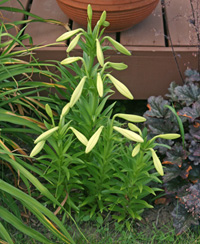
L. longiflorum does best in full sun in well-drained soil. Place the bulbs or plants 12-18” apart, with the bulb about 3” deep. Mulch around the plants to insulate the soil (these lilies prefer cool soil) or plant a low ground cover of shallow-rooted, complementary annuals or perennials between the lilies to cover the ground. Deadhead after the blooms wither by cutting off the flowering portion of the stalk. The leaves will remain green and attractive through the growing season and turn yellow in the fall. Cut the entire stem back to the soil level when it has died back. Use bulb fertilizer or blood meal as a top dressing in the fall; work this into the soil being careful not to disturb the lily roots. Regular fertilizer can be applied in the spring when growth appears and monthly until blooming. Extra mulch applied after the ground freezes may benefit survival in colder climates – this should be removed in the spring when the new shoots begin to emerge. This lily has few pests, although aphids may sometimes infest the plants.
Plants can be propagated by seed or division of the bulb. The scales of the bulbs can be separated, or the small offsets – bulblets – can be removing and planted to form new bulbs. Both scales and bulblets need 2-3 years to get to blooming size. Dig, divide and replant the bulbs in the late summer or fall after blooming.
Forced Easter Lilies
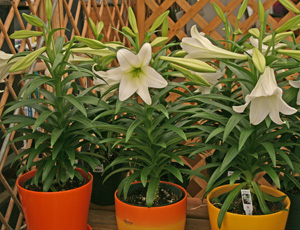
Choose plants with dense foliage along the entire stem and that are an appropriate size for the pot (about twice as tall as the pot). For maximum length of bloom, choose a plant that has lots of buds in various stages of development, with only one or two flowers opened. Inspect the plants for evidence of pests and avoid any on which you see insect eggs, mite webbing, or holes chewed in the leaves. Also pass over any plants that have dark spots on the leaves or crinkled or wilted leaves, as they may be diseased.
In the home display Easter lilies in bright, indirect light in an area where temperatures are uniform (not subject to drafts or exposed to direct heat, such as from fireplaces or heating ducts). As with other flowers, fairly cool daytime temperatures (60-65°F) will prolong the life of the blooms. Night temperatures should be slightly cooler at 55-60°F. Try to maintain even soil moisture – do not let it sit in water or remain dry for more than a day or two. If the pot is in a decorative foil wrapper, make sure water is not accumulating under the pot. You may wish to remove the yellow anthers from the flowers so that shedding pollen will not stain the flowers or other objects it may fall onto. This will also help prolong the blooms. As the flowers fade and wither, remove by cutting or pinching at the attachment to the stem. Once the plant is done blooming, move it to a sunny spot indoors.
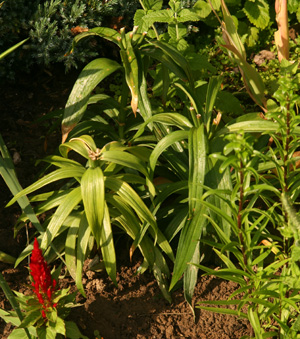
After all risk of frost is past, move forced Easter lilies outdoors, gradually acclimating them to the new conditions over about a week. Then plant in the ground in a suitable spot, placing it at the same depth as it was in the pot or a few inches deeper. If the plant is rootbound, loosen the roots and spread out in the planting hole. The leaves and stem will soon start to turn brown, but within a few weeks new growth should come up from the base of the plant. The plant may even bloom again in late summer if you are lucky! Or you can let the plant go dormant in its pot, store the bulb over the winter and plant outdoors the following spring. Forced plants may not bloom the following year, but should eventually rebloom at the normal time.
NOTE: Easter lilies, and many other types of lilies, are poisonous to cats. If ingested they cause kidney failure. If you think a cat has eaten a leaf, call a veterinarian immediately as prompt treatment often can be successful.
– Susan Mahr, University of Wisconsin – Madison





 Alternatives to Lawn: Groundcovers
Alternatives to Lawn: Groundcovers Marigolds
Marigolds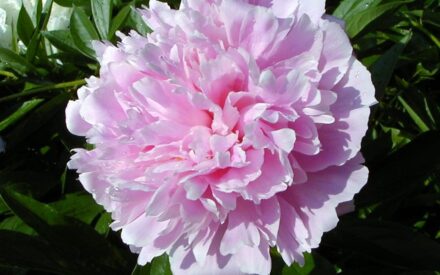 Peony
Peony Iris Severe Mosaic
Iris Severe Mosaic


